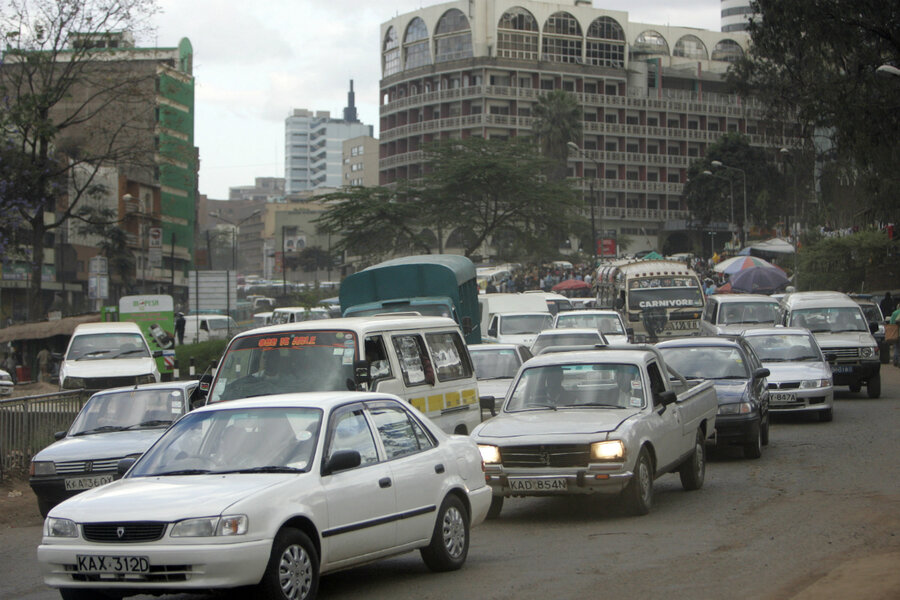More people choosing to walk, instead of drive, in congested Nairobi
Loading...
| Nairobi, Kenya
It is dawn along the Waiyaki Way highway on the northwest side of Nairobi, but road into town is already packed with traffic of every stripe.
As a 14-seater van skids into a bus stop, a young man in denim jeans and a yellow sweatshirt peels out the door, beckoning to passengers looking for a ride to town.
The more energetic ones shove their way through the crowd to the vehicle’s doorway. But only one pair manages to squeeze into the two empty passenger seats. Restlessly, the others pull back to wait for the next passenger vehicle.
But nearby, a smiling Mercy Njoroge walks briskly by on her own more efficient transport system: her feet.
Ms. Njoroge, a mid-career accountant, is among a growing number of the city’s workers who are opting to walk to work, both to avoid the daily traffic scramble and because they want to cut air pollution caused by vehicle emissions.
“I have a car but I only use it during weekends because there are fewer people and traffic going into the city,” Njoroge said in an interview with the Thomson Reuters Foundation.
“My choice to walk to and from work was inspired by the need to do something about the environment and pollution that is ailing our city," she said.
She walks an impressive eight kilometers (about five miles) each day between her home and her office, at an organization that lobbies to protect maids and other household workers. But a growing share of Nairobi residents are similarly taking to their feet, though usually over shorter distances.
According to the Nairobi county environment department, the city’s middle class is increasingly showing an interest in protecting the environment – and avoiding traffic – with at least 1 in 10 middle class commuters now walking to work instead of driving.
“This is in solidarity to cutting air pollution,” said Mahmoud Dagane, a county executive committee member who has worked on environment and transport issues, at the January launch of a Nairobi beautification program.
More Kenyans living within five kilometers (about three miles) of their jobs need to walk or ride a bicycle to work to reduce the amount of traffic on Nairobi’s roads, he said.
Smog and soot
Nairobi’s need to get more people out of vehicles is evident in a place where perpetual traffic snarls are a major source of frustration and pollution.
From Waiyaki Way highway, a smoggy blanket is visible hanging over downtown Nairobi’s tall buildings, and pockets of trees along the road are covered with traffic soot. Occasionally a pedestrian lets out a dry cough as fumes waft from slow-moving vehicles.
According to the United Nations Environment Program (UNEP), 6.5 million people die annually around the world due to poor air quality.
A 2016 report on the costs of air pollution in Africa, by the Organization for Economic Co-operation and Development (OECD), estimated that premature deaths from outdoor air pollution cost African nations $215 billion in 2013.
At a press conference in March in Nairobi, Rob De Jong, the head of UNEP’s mobility unit, said transport contributes over half of outdoor air pollution in African cities.
“This is made worse because Africa continues to import old vehicles which are known to be heavy emitters of pollutants,” he said. He said a ban should be put in place on importing vehicles over 15 years old.
The number of vehicles on Kenya’s roads is increasing, with more than 7,000 a month added in Nairobi alone, or about 90,000 a year, according to the National Transport and Safety Authority (NTSA), a government agency.
Shade and a snack?
Delegates to an Africa Clean Mobility Week event held in Nairobi last month recommended that African countries, including Kenya, begin using more hybrid vehicles – which combine clean electric power with traditional fuel – to cut pollution.
Kenya already has reduced the consumption of fuel with high levels of polluting sulfur by tightening diesel import laws, said Jane Akumu, who works on promoting clean fuels and vehicles for Africa at United Nations Environment.
But simpler solutions – such as more walking and cycling – are a more sustainable way to cut traffic pollution, she said.
Over half of Kenyans already walk or ride a bicycle as transport, Ms. Akumu said, but face tough conditions, including a lack of safe and pleasant pathways that avoid traffic.
“Why doesn’t the country have good infrastructure for walking and cycling?” she asked.
She suggested Kenya build separate lanes along highways for people walking and riding bicycles, preferably lined with fruit trees to provide shade and even an occasional snack.
“This can enable Kenya to save in terms of the fuel import bill and also contribute to reduce forces that cause climate change,” Akumu said. “These are the kind of innovations that countries can introduce.”
This story was reported by The Thomson Reuters Foundation.







